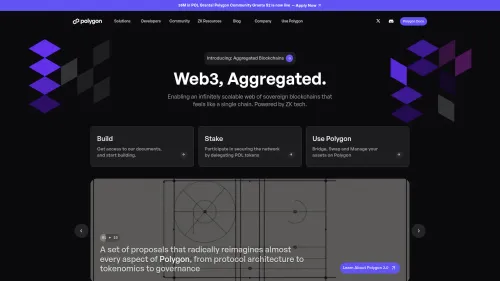Polygon PoS Bridged DAI (Polygon POS) (DAI)
Polygon, formerly known as Matic Network, is a protocol and a framework for building and connecting Ethereum-compatible blockchain networks. Its primary purpose is to solve some of Ethereum's major limitations, including its throughput, poor user experience (high speed and delayed transactions), and lack of community governance. Polygon combines the best of Ethereum and sovereign blockchains into a full-fledged multi-chain system.
History of Polygon
Polygon was founded in 2017 by Jaynti Kanani, Sandeep Nailwal, Anurag Arjun, and Mihailo Bjelic. Initially launched as Matic Network, the project aimed to deliver scalable, secure, and instant Ethereum transactions using Layer 2 sidechains. In February 2021, Matic Network rebranded to Polygon to expand its mission and support a wider variety of scaling solutions beyond its original Plasma-based chain.

| Ticker | DAI |
| Category | Polygon Ecosystem |
| Website | https://polygon.technology/ |
| Contract Addresses | |
|---|---|
| polygon-pos | 0x8f...63 Copied! Copied! |
The technology behind Polygon
Polygon utilizes a variety of technologies to enhance the capabilities of the Ethereum network. At its core, Polygon is a Layer 2 scaling solution that uses a modified version of the Plasma framework to provide fast and low-cost transactions.
Plasma framework
Plasma is a framework proposed to increase Ethereum’s scalability by creating a tree of sidechains that can handle a large number of transactions off the main Ethereum chain. Polygon leverages this framework to enable faster transaction processing and to reduce the load on the Ethereum mainnet.
Proof-of-stake consensus
Polygon employs a proof-of-stake (PoS) consensus mechanism, where validators are selected based on the quantity of the native MATIC token they hold and are willing to "stake" as collateral. This ensures the security and integrity of the network while promoting decentralization.
Compatibility with Ethereum
Polygon is built to be compatible with Ethereum’s existing infrastructure. This means that any Ethereum smart contract can be easily ported to Polygon, enabling developers to take advantage of the network’s enhanced capabilities without having to rebuild their applications from scratch.
Polygon architecture
Polygon's architecture can be described as a four-layer system, consisting of the Ethereum layer, security layer, Polygon networks layer, and execution layer.
Ethereum layer
The Ethereum layer is a set of smart contracts on Ethereum that handle functions like staking, dispute resolution, and finality. This layer leverages Ethereum's security and provides a foundation for the Polygon network.
Security layer
The optional security layer operates as a "validators as a service" framework. It runs in parallel to Ethereum and provides a set of validators that periodically check the validity of any Polygon chain. This layer can be utilized to enhance security if needed.
Polygon networks layer
This layer is responsible for managing a collection of sovereign blockchain networks. Each network can have its own consensus, block producers, and community governance. The Polygon networks layer is what enables the creation of diverse blockchain solutions within the Polygon ecosystem.
Execution layer
The execution layer is where the actual transaction processing and smart contract execution occur. It consists of two sub-layers: the execution environment and execution logic. This layer ensures that transactions are processed efficiently and accurately.
Use cases and applications
Polygon has been adopted by a variety of projects and platforms to enhance scalability and performance. Some of the common use cases include:
Decentralized finance (DeFi)
Polygon is widely used in the DeFi space to provide faster and cheaper transactions. By reducing congestion and transaction fees, Polygon enables DeFi platforms to offer services to a broader audience.
Non-fungible tokens (NFTs)
The NFT market has benefited from Polygon’s capabilities, allowing creators and platforms to mint and trade NFTs with reduced costs and improved transaction speeds. This has opened up new opportunities for artists and collectors.
Gaming
Polygon's scalable infrastructure is ideal for blockchain-based gaming applications, which require quick and low-cost transactions. This enables developers to create more interactive and engaging gaming experiences.
